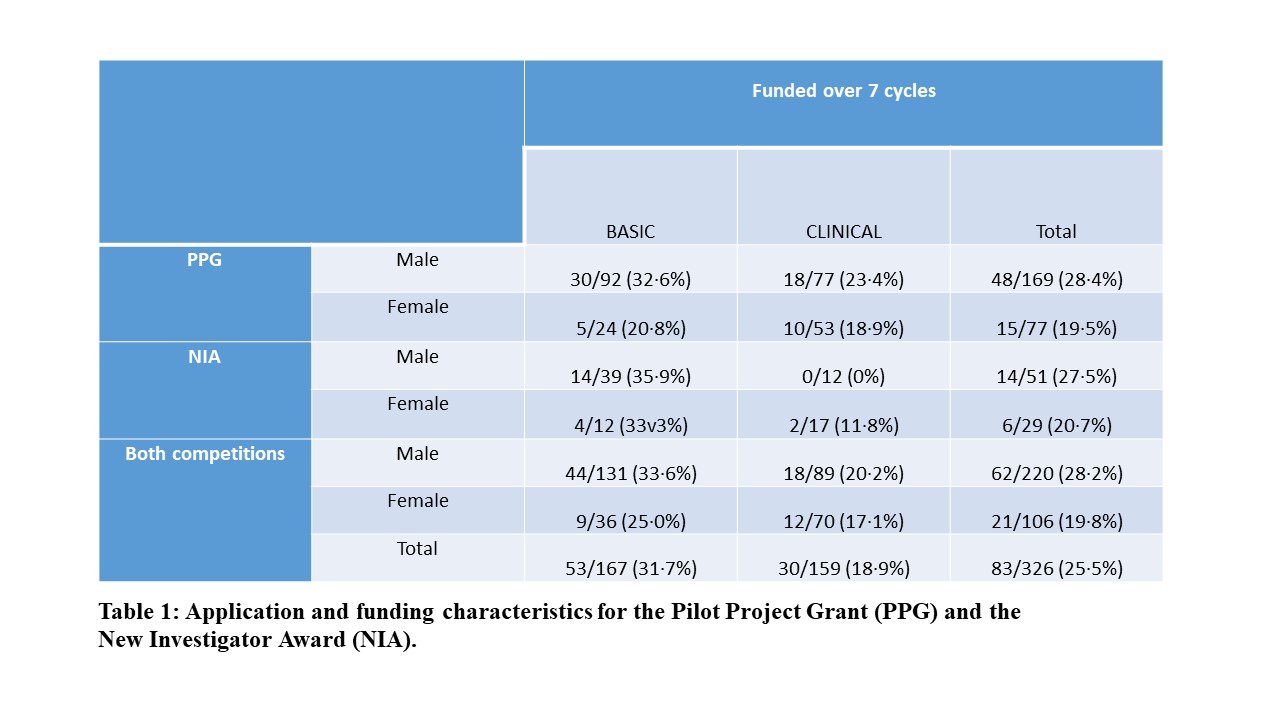Session Information
Date: Monday, September 23, 2019
Session Title: Other
Session Time: 1:45pm-3:15pm
Location: Agora 2 West, Level 2
Objective: To review the interaction of gender, career stage and application type with success rates in grant competitions at a National granting agency in movement disorders.
Background: Despite efforts to boost gender equity in science, large gaps remain.(1) Here we present data from Parkinson Canada, a National funding agency to shine light on gender equity in the field of movement disorders. Parkinson Canada offers two annual competitions, the pilot project grant (PPG) and the New Investigator Award (NIA), focusing on the merit of the scientific project and on the research potential of early career investigators, respectively. Grants are reviewed by the same scientific panel for both streams.
Method: We reviewed grant applications for competitions from 2012 to 2018 for both competition streams, collecting data on gender of primary applicant, basic or clinical science stream and competition success as well as gender composition of the scientific review panel.
Results: A total of 326 applications were submitted over the 7 year time frame, 220 by male, 106 by female researchers (see table 1). Overall success rates for applications by men were 62/220 (28·2%) and 21/106 (19·8%) for those by women. Basic science applications were more likely to be funded than clinical ones (53/167 (31·7%) vs. 30/159 (18·9%), p=0·011). Men submitted more basic sciences applications ((men=60% basic, women=34% basic, OR=2·8,p<0·001). A logistic regression model revealed that basic science applications were more likely to be funded than clinical ones ((OR=1·91 (95%CI=1·12-3·25, p=0·018), without significant differences in gender or competition stream. When adjusting for basic and clinical sciences streams, gender-associated success rates were not significantly different in either competition (OR for females in PPG=0·67 (95%CI=0·34-1·30) vs. NIA=1·26 (95%CI=0·37-4·25). The scientific board had 15/104 (14%) female and 89/104 (86%)(p<0·001) male members over the 7 years.
Conclusion: Women were significantly underrepresented in overall grant submissions, basic science submissions and scientific review board membership. Of note, evaluations of research potential in early career (NIA competition) did not differ between men and women. Gender gaps affect the field of movement disorders and require the collective attention of our scientific community.
References: Witteman HO, Hendricks M, Straus S, Tannenbaum C. Are gender gaps due to evaluations of the applicant or the science? A natural experiment at a national funding agency. Lancet. 2019 Feb 9;393(10171):531–40.
To cite this abstract in AMA style:
S. Appel-Cresswell, P. Blanchet, J. Wysocki, R. Postuma. Gender gap in scientific granting competitions in movement disorders – insights from a national Canadian funding agency [abstract]. Mov Disord. 2019; 34 (suppl 2). https://www.mdsabstracts.org/abstract/gender-gap-in-scientific-granting-competitions-in-movement-disorders-insights-from-a-national-canadian-funding-agency/. Accessed January 7, 2026.« Back to 2019 International Congress
MDS Abstracts - https://www.mdsabstracts.org/abstract/gender-gap-in-scientific-granting-competitions-in-movement-disorders-insights-from-a-national-canadian-funding-agency/

